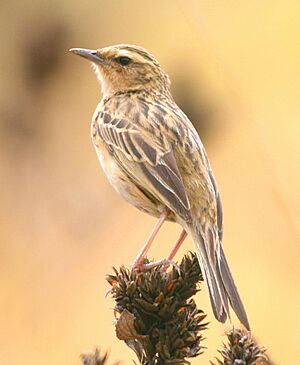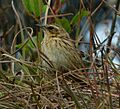Nilgiri pipit facts for kids
Quick facts for kids Nilgiri pipit |
|
|---|---|
 |
|
| Conservation status | |
| Scientific classification | |
| Genus: |
Anthus
|
| Species: |
nilghiriensis
|
The Nilgiri pipit (Anthus nilghiriensis) is a special type of pipit bird. It lives only in the high mountains of southern India. This bird is a richer brown color than other pipits in the area. You can spot it by the streaks on its chest that continue down its sides. It does not migrate, meaning it stays in one place all year. When it is disturbed, it often flies into low trees. It is closely related to other pipits like the tree pipit.
Contents
About the Nilgiri Pipit
The Nilgiri pipit is a small bird, about 12.6 to 14 centimeters long. It has rich brown colors. Its face has dark areas around the eyes, and a light buff stripe above its eye and on its throat. It does not have dark stripes on its cheeks.
The sides of its neck, chest, and flanks are a brighter buff color. Its beak is completely dark. The top of its head has many black streaks, just like its upper body. The outer feathers of its tail are also buff colored. You won't see any white feathers on this bird. The streaks on its chest are fine and go all the way down its sides. Sometimes, very rare Nilgiri pipits can be born completely white, which is called albinism.
How the Nilgiri Pipit Got Its Name
This bird was first described by a person named Thomas C. Jerdon in 1840. He called it Anthus rufescens. But this name had already been used for a different bird. Later, another person named Blyth called it Anthus montanus. These names were not valid.
So, in 1885, Richard Bowdler Sharpe gave it a new, proper name: A. nilghiriensis. This is the name we use today. The Nilgiri pipit is closely related to other tree pipits. It is like a close cousin to the Anthus trivialis and Anthus hodgsoni pipits. It separated from these relatives a very long time ago, during a period called the Pliocene epoch.
Where the Nilgiri Pipit Lives
The Nilgiri pipit likes to live in short montane grasslands. These are grassy areas found in mountains. It also likes places with marshy ground and small streams. You can usually find them on hill slopes. In some areas, they live above 1,000 meters (about 3,300 feet). In other places, like the Nilgiris, they live above 1,500 meters (about 4,900 feet).
They have been seen in the Ponmudi hills, Nilgiris, Palani hills, and High Ranges. Some people thought they lived in the Kalakkad Mundanthurai Tiger Reserve. However, a study in 2014 showed they mostly live in the high grassy peaks of the Nilgiris and the Anamalais. There are old museum samples from the Palani ranges. But changes to their habitat might have made them disappear from those areas. Recent surveys haven't found them there.
Nilgiri Pipit Behaviour and Reproduction
Nilgiri pipits are usually seen alone or in pairs. If something scares them, they will quickly fly into a low bush or tree to hide.
They build their nests and lay eggs in the summer, from April to July. Their nest is shaped like a cup and is made of grass. They build it hidden in short grass. A female pipit usually lays two or three eggs. These eggs are grey-brown with speckles.
Nilgiri pipits eat mostly grass seeds and insects. During the breeding season, they eat more invertebrates, which are small creatures like worms or spiders.
Status of the Nilgiri Pipit
The Nilgiri pipit is considered a vulnerable species. This means its population is decreasing and it could become endangered. Scientists estimate there are about 4,000 of these birds left in the world. This is based on how many birds they find in suitable habitats.
The grassy areas where these birds live are in danger. People are planting trees like wattle, which take over the grasslands. Also, other plants like broom (Cytisus scoparius) are spreading in the Nilgiris. Fires are also a threat to their homes.
Images for kids




